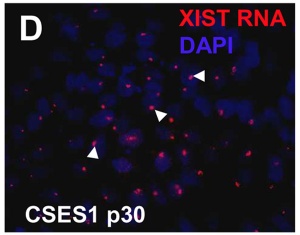Molecular Development - X Inactivation: Difference between revisions
No edit summary |
|||
| Line 5: | Line 5: | ||
A second form of X inactivation that occurs only in male meiotic spermatogenesis, meiotic sex chromosome inactivation (MSCI), is not covered in these current notes. MSCI is the process of transcriptional silencing of the X and Y chromosomes. (More? Meiotic sex chromosome inactivation. Turner JM. Development. 2007 May;134(10):1823-31.) | A second form of X inactivation that occurs only in male meiotic spermatogenesis, meiotic sex chromosome inactivation (MSCI), is not covered in these current notes. MSCI is the process of transcriptional silencing of the X and Y chromosomes. (More? Meiotic sex chromosome inactivation. Turner JM. Development. 2007 May;134(10):1823-31.) | ||
Xist RNA, a 17 kb non-coding RNA, accumulates on the future inactive X chromosome.<ref name="PMID1985261" | Xist RNA, a 17 kb non-coding RNA, accumulates on the future inactive X chromosome.<ref name="PMID1985261"><pubmed>13764598</pubmed></ref> | ||
==Some Recent Findings== | ==Some Recent Findings== | ||
Revision as of 12:09, 18 July 2010
Introduction

The presence in females of 2 X chromosome raises the issue of gene dosage, in the case of mammals this is regulated by inactivating one of the X chromosomes (see X inactivation notes). In some other species compensation occurs by increasing the expression of X in males. The pattern of which X chromosome is inactivated in cells appears to be random, generating 50% cells expressing Father X, 50% cells expressing Mother X (mosaic pattern). The theory of random X inactivation was first suggested in mice in 1961.
A second form of X inactivation that occurs only in male meiotic spermatogenesis, meiotic sex chromosome inactivation (MSCI), is not covered in these current notes. MSCI is the process of transcriptional silencing of the X and Y chromosomes. (More? Meiotic sex chromosome inactivation. Turner JM. Development. 2007 May;134(10):1823-31.)
Xist RNA, a 17 kb non-coding RNA, accumulates on the future inactive X chromosome.[2]
Some Recent Findings
- Variations of X chromosome inactivation occur in early passages of female human embryonic stem cells.[1]"Human embryonic stem cells (hESCs) derived from inner cell mass (ICM) of blastocyst stage embryos have been used as a model system to understand XCI initiation and maintenance. Previous studies of undifferentiated female hESCs at intermediate passages have shown three possible states of XCI; 1) cells in a pre-XCI state, 2) cells that already exhibit XCI, or 3) cells that never undergo XCI even upon differentiation. In this study, XCI status was assayed in ten female hESC lines between passage 5 and 15 to determine whether XCI variations occur in early passages of hESCs. Our results show that three different states of XCI already exist in the early passages of hESC. "
- Random X inactivation and extensive mosaicism in human placenta [3] "Our results illustrate the differences of XCI mechanism between humans and mice, and highlight the importance of addressing the issue of imprinted XCI in other species in order to understand the evolution of dosage compensation in placental mammals."
X Inactivation (xist) History
The theory of random X inactivation was first suggested in mice in 1961.[4] The breakthrough was the discovery of the X inactive specific transcript (XIST). [2] This gene is located within the "X inactivation centre" and only expressed by the inactive X chromosome. unlike other genes that encode protein XIST contained no "open reading frames" (ie no codons to encode amino acids). XIST is transcribed but not translated. XIST appears to act as RNA. Current thinking is that it binds to the X Chromosome and is involved in it's translocation to the nuclear periphery. It now appears that XIST appears to initiate X inactivation and it is the methylation of the inactive X genes that maintains inactivity.
References
Search Pubmed
July 2010 "X Inactivation" - All (3157) Review (519) Free Full Text (1066)
Search Pubmed Now: X Inactivation
Glossary Links
- Glossary: A | B | C | D | E | F | G | H | I | J | K | L | M | N | O | P | Q | R | S | T | U | V | W | X | Y | Z | Numbers | Symbols | Term Link
Cite this page: Hill, M.A. (2024, May 3) Embryology Molecular Development - X Inactivation. Retrieved from https://embryology.med.unsw.edu.au/embryology/index.php/Molecular_Development_-_X_Inactivation
- © Dr Mark Hill 2024, UNSW Embryology ISBN: 978 0 7334 2609 4 - UNSW CRICOS Provider Code No. 00098G